Research on the Spatial Heterogeneity and Influencing Factors of Air Pollution: A Case Study in Shijiazhuang, China
Abstract
:1. Introduction
2. Materials and Methods
2.1. Study Area
2.2. Data and Preprocessing
2.2.1. Data Resources
- Data related to natural factors: air pollution data were the annual average AOD numerical raster data calculated from the inversion of 2020 MCD19A2 remote sensing data, with a data resolution of 1 km. Wind speed monitoring data came from the China Meteorological Data Service Data Center (http://data.cma.cn, accessed on 1 March 2021), and the average annual wind speed and wind direction data of 17 meteorological monitoring stations in Shijiazhuang were calculated. LST data were derived from the annual average LST raster data calculated from the inversion of 2020 MYD11A2 remote sensing data with a data resolution of 1 km. ASTER GDEM 30 M data came from the Geospatial Data Cloud platform of the Computer Network Information Center of the Chinese Academy of Sciences (http://www.gscloud.cn, accessed on 1 March 2021). The forest, grassland, cultivated land, and artificial land data were from a land cover dataset of GlobeLand30 (National Catalog Service for Geographic Information: http://www.webmap.cn, accessed on 1 March 2021), with a data resolution of 30 m. The data were evaluated by the Aerospace Information Research Institute of the Chinese Academy of Sciences for accuracy and had an overall accuracy of 85.72% and high reliability. Vector data of river systems were obtained from the National Geomatics Center of China (http://www.ngcc.cn/ngcc, accessed on 1 March 2021).
- Data related to human factors: Population distribution data came from WorldPop, an open spatial demographic data and research program (https://www.worldpop.org/, accessed on 1 March 2021), with a data resolution of 100 m. Point of interest (POI) data of industrial enterprises and building contour and height data came from Amap API (https://lbs.amap.com/, accessed on 1 March 2021) with high accuracy. Road traffic vector data came from the National Geomatics Center of China (http://www.ngcc.cn/ngcc/, accessed on 1 March 2021) and the Open Street Map (https://www.openstreetmap.org/, accessed on 1 March 2021). In this study, the road vector data were processed into three types of road density factors using the line density analysis tool of ArcGIS. Among them, the total road density includes all urban and regional roads, the main road density includes regional roads such as highways, and the urban road density includes all levels of city roads. The nighttime light data were from the Nighttime-Light Dataset of the Chinese Academy of Sciences (Flint), calculated and generated based on Suomi NPP VIIRS night light remote sensing data, with a resolution of 500 m. The nighttime light data were widely used to reflect the distribution of population and economic activity; the brighter the lights, the more developed the economy.
2.2.2. Preprocessing
2.3. Methods
3. Results
3.1. Analysis of the Spatial Heterogeneity Characteristics of Air Pollution in Shijiazhuang
3.2. Identification of Influencing Factors of Air Pollution in Shijiazhuang
3.3. Analysis of the Interaction and Mechanism of Air Pollution Influencing Factors
4. Discussion
5. Conclusions
- (1)
- Spatial distribution characteristics of air pollution: within the administrative region of Shijiazhuang, air pollution shows obvious characteristics of high-value agglomeration and heterogeneity. The high agglomeration areas are concentrated in the eastern plain areas where human factors such as industry and population are concentrated, and low agglomeration areas are concentrated in the western mountainous areas.
- (2)
- The main individual influencing factors of air pollution spatial heterogeneity: forest (q = 0.620), slope (q = 0.616), elevation (q = 0.579), grassland (q = 0.534), and artificial surface (q = 0.506) are the main individual factors affecting AOD distribution. Among them, natural factors such as topography, ecological space, and wind speed are negatively correlated with AOD values, whereas the opposite is true for human factors such as roads, artificial surfaces, and population. These human factors reflect the density of the urban built-up environment and the agglomeration degree of population and economic activity. Therefore, high-density built-up areas should be considered as the key areas for pollution control.
- (3)
- The interaction effects among factors: each factor can barely affect the air pollution status significantly alone. The explanatory power of all influencing factors showed an improvement through the two-factor enhanced interaction. The associations of elevation ∩ artificial surface (q = 0.625), elevation ∩ NDVI (q = 0.622), and elevation ∩ grassland (q = 0.620) exhibited a high explanatory power on AOD value distribution. The highest AOD value appears in the places with lower elevation, high-density built environment, and sparse vegetation cover.
Author Contributions
Funding
Data Availability Statement
Conflicts of Interest
References
- Chan, C.; Yao, X. Air pollution in mega cities in China. Atmos. Environ. 2008, 42, 1–42. [Google Scholar] [CrossRef]
- Xie, Y.; Dai, H.; Zhang, Y.; Wu, Y.; Hanaoka, T.; Masui, T. Comparison of health and economic impacts of PM2.5 and ozone pollution in China. Environ. Int. 2019, 130, 104881. [Google Scholar] [CrossRef] [PubMed]
- Dong, D.; Xu, B.; Shen, N.; He, Q. The Adverse Impact of Air Pollution on China’s Economic Growth. Sustainability 2021, 13, 9056. [Google Scholar] [CrossRef]
- Jerrett, M. The death toll from air-pollution sources. Nature 2015, 525, 330–331. [Google Scholar] [CrossRef] [PubMed] [Green Version]
- Lelieveld, J.; Evans, J.S.; Fnais, M.; Giannadaki, D.; Pozzer, A. The contribution of outdoor air pollution sources to premature mortality on a global scale. Nature 2015, 525, 367–371. [Google Scholar] [CrossRef]
- Crane, K.; Mao, Z. Costs of Selected Policies to Address Air Pollution in China; RAND Corporation: Santa Monica, CA, USA, 2015. [Google Scholar]
- Fang, C.; Liu, H.; Li, G. International progress and evaluation on interactive coupling effects between urbanization and the eco-environment. J. Geogr. Sci. 2016, 26, 1081–1116. [Google Scholar] [CrossRef]
- Wang, B.; Hong, G.; Qin, T.; Fan, W.; Yuan, X. Factors governing the willingness to pay for air pollution treatment: A case study in the Beijing-Tianjin-Hebei region. J. Clean. Prod. 2019, 235, 1304–1314. [Google Scholar] [CrossRef]
- Liang, C.; Duan, F.; He, K.; Ma, Y. Review on recent progress in observations, source identifications and countermeasures of PM2.5. Environ. Int. 2016, 86, 150–170. [Google Scholar] [CrossRef] [PubMed]
- Wu, T.; Zhou, L.; Jiang, G.; Meadows, M.; Zhang, J.; Pu, L.; Wu, C.; Xie, X. Modelling Spatial Heterogeneity in the Effects of Natural and Socioeconomic Factors, and Their Interactions, on Atmospheric PM2.5 Concentrations in China from 2000–2015. Remote Sens. 2021, 13, 2152. [Google Scholar] [CrossRef]
- Pui, D.; Chen, S.; Zuo, Z. PM2.5 in China: Measurements, sources, visibility and health effects, and mitigation. Particuology 2014, 13, 1–26. [Google Scholar] [CrossRef]
- Streets, D.; Waldhoff, S. Present and future emissions of air pollutants in China: SO2, NOx, and CO. Atmos. Environ. 2000, 34, 363–374. [Google Scholar] [CrossRef]
- Lu, C.; Liu, Y. Effects of China’s urban form on urban air quality. Urban Stud. 2015, 53, 2607–2623. [Google Scholar] [CrossRef]
- Clark, L.P.; Millet, D.B.; Marshall, J.D. Air Quality and Urban Form in US Urban Areas: Evidence from Regulatory Monitors. Environ. Sci. Technol. 2011, 45, 7028–7035. [Google Scholar] [CrossRef]
- McCarty, J.; Kaza, N. Urban form and air quality in the United States. Landsc. Urban Plan. 2015, 139, 168–179. [Google Scholar] [CrossRef]
- Guan, D.; Su, X.; Zhang, Q.; Peters, G.P.; Liu, Z.; Lei, Y.; He, K. The socioeconomic drivers of China’s primary PM. Environ. Res. Lett. 2014, 9, 024010. [Google Scholar] [CrossRef] [Green Version]
- He, L.; Zhang, L.; Liu, R. Energy consumption, air quality, and air pollution spatial spillover effects: Evidence from the Yangtze River Delta of China. Chin. J. Popul. Resour. Environ. 2019, 17, 329–340. [Google Scholar] [CrossRef]
- Li, J.; Hou, L.; Wang, L.; Tang, L. Decoupling Analysis between Economic Growth and Air Pollution in Key Regions of Air Pollution Control in China. Sustainability 2021, 13, 6600. [Google Scholar] [CrossRef]
- Wang, X.; Klemes, J.; Dong, X.; Fan, W.; Xu, Z.; Wang, Y.; Varbanov, P. Air pollution terrain nexus: A review considering energy generation and consumption. Renew. Sustain. Energy Rev. 2019, 105, 71–85. [Google Scholar] [CrossRef]
- Yang, J.; Shi, B.; Shi, Y.; Marvin, S.; Zheng, Y.; Xia, G. Air pollution dispersal in high density urban areas: Research on the triadic relation of wind, air pollution, and urban form. Sustain. Cities Soc. 2020, 54, 101941. [Google Scholar] [CrossRef]
- Matos, P.; Vieira, J.; Rocha, B.; Branquinho, C.; Pinho, P. Modeling the provision of air-quality regulation ecosystem service provided by urban green spaces using lichens as ecological indicators. Sci. Total Environ. 2019, 665, 521–530. [Google Scholar] [CrossRef] [PubMed]
- Zhan, D.; Kwan, M.; Zhang, W.; Wang, S.; Yu, J. Spatiotemporal Variations and Driving Factors of Air Pollution in China. Int. J. Environ. Res. Public Health 2017, 14, 1538. [Google Scholar] [CrossRef] [PubMed] [Green Version]
- Bai, L.; Jiang, L.; Yang, D.; Liu, Y. Quantifying the spatial heterogeneity influences of natural and socioeconomic factors and their interactions on air pollution using the geographical detector method: A case study of the Yangtze River Economic Belt, China. J. Clean. Prod. 2019, 232, 692–704. [Google Scholar] [CrossRef]
- Zhan, D.; Kwan, M.-P.; Zhang, W.; Yu, X.; Meng, B.; Liu, Q. The driving factors of air quality index in China. J. Clean. Prod. 2018, 197, 1342–1351. [Google Scholar] [CrossRef]
- Zhang, X.; Shi, M.; Li, Y.; Pang, R.; Xiang, N. Correlating PM2.5 concentrations with air pollutant emissions: A longitudinal study of the Beijing-Tianjin-Hebei region. J. Clean. Prod. 2018, 179, 103–113. [Google Scholar] [CrossRef]
- Yu, H.-L.; Lin, Y.-C.; Kuo, Y.-M. A time series analysis of multiple ambient pollutants to investigate the underlying air pollution dynamics and interactions. Chemosphere 2015, 134, 571–580. [Google Scholar] [CrossRef] [PubMed]
- Pandey, B.; Agrawal, M.; Singh, S. Assessment of air pollution around coal mining area: Emphasizing on spatial distributions, seasonal variations and heavy metals, using cluster and principal component analysis. Atmos. Pollut. Res. 2014, 5, 79–86. [Google Scholar] [CrossRef] [Green Version]
- Wang, L.; Chen, J. Socio-economic influential factors of haze pollution in china: Empirical study by eba model using spatial panel data. Acta Sci. Circumstantiae 2016, 36, 3833–3839. [Google Scholar] [CrossRef]
- Liu, H.; Fang, C.; Zhang, X.; Wang, Z.; Bao, C.; Li, F. The effect of natural and anthropogenic factors on haze pollution in Chinese cities: A spatial econometrics approach. J. Clean. Prod. 2017, 165, 323–333. [Google Scholar] [CrossRef]
- Hao, Y.; Liu, Y.-M. The influential factors of urban PM2.5 concentrations in China: A spatial econometric analysis. J. Clean. Prod. 2016, 112, 1443–1453. [Google Scholar] [CrossRef]
- Huang, L.; Zhang, C.; Bi, J. Development of land use regression models for PM2.5, SO2, NO2 and O3 in Nanjing, China. Environ. Res. 2017, 158, 542–552. [Google Scholar] [CrossRef] [PubMed]
- Xu, S. Analysis of the Influencing Factors of Industrial Air Pollution in Shenzhen. IOP Conf. Ser. Earth Environ. Sci. 2020, 450, 012094. [Google Scholar] [CrossRef]
- Zhou, D.; Lin, Z.; Liu, L.; Qi, J. Spatial-temporal characteristics of urban air pollution in 337 Chinese cities and their influencing factors. Environ. Sci. Pollut. Res. 2021, 28, 36234–36258. [Google Scholar] [CrossRef] [PubMed]
- Zhang, X.; Yan, B.; Du, C.; Cheng, C.; Zhao, H. Quantifying the interactive effects of meteorological, socioeconomic, and pollutant factors on summertime ozone pollution in China during the implementation of two important policies. Atmos. Pollut. Res. 2021, 12, 101248. [Google Scholar] [CrossRef]
- Zhang, X.; Cheng, C. Temporal and Spatial Heterogeneity of PM2.5 Related to Meteorological and Socioeconomic Factors across China during 2000–2018. Int. J. Environ. Res. Public Health 2022, 19, 707. [Google Scholar] [CrossRef] [PubMed]
- Wang, J.F.; Li, X.H.; Christakos, G.; Liao, Y.L.; Zhang, T.; Gu, X.; Zheng, X.Y. Geographical Detectors-Based Health Risk Assessment and its Application in the Neural Tube Defects Study of the Heshun Region, China. Int. J. Geogr. Inf. Sci. 2010, 24, 107–127. [Google Scholar] [CrossRef]
- Jing, Z.; Liu, P.; Wang, T.; Song, H.; Lee, J.; Xu, T.; Xing, Y. Effects of Meteorological Factors and Anthropogenic Precursors on PM2.5 Concentrations in Cities in China. Sustainability 2020, 12, 3550. [Google Scholar] [CrossRef]
- Zhao, P.; Zhang, X.; Xu, X.; Zhao, X. Long-term visibility trends and characteristics in the region of Beijing, Tianjin, and Hebei, China. Atmos. Res. 2011, 101, 711–718. [Google Scholar] [CrossRef]
- China National Environmental Monitoring Centre. Report on the National Surface Water and Ambient Air Quality Status in 2020; Ministry of Ecology and Environment: Beijing, China, 2021. [Google Scholar]
- Wang, S.; Ma, H.; Zhao, Y. Exploring the relationship between urbanization and the eco-environment-A case study of Beijing-Tianjin-Hebei region. Ecol. Indic. 2014, 45, 171–183. [Google Scholar] [CrossRef]
- Maji, K.J.; Dikshit, A.K.; Arora, M.; Deshpande, A. Estimating premature mortality attributable to PM2.5 exposure and benefit of air pollution control policies in China for 2020. Sci. Total Environ. 2018, 612, 683–693. [Google Scholar] [CrossRef]
- Miao, Y.; Hu, X.; Liu, S.; Qian, T.; Xue, M.; Zheng, Y.; Wang, S. Seasonal variation of local atmospheric circulations and boundary layer structure in the Beijing-Tianjin-Hebei region and implications for air quality. J. Adv. Model. Earth Syst. 2015, 7, 1602–1626. [Google Scholar] [CrossRef]
- Li, N.; Zhang, X.; Shi, M.; Hewings, G.J.D. Does China’s air pollution abatement policy matter? An assessment of the Beijing-Tianjin-Hebei region based on a multi-regional CGE model. Energy Policy 2019, 127, 213–227. [Google Scholar] [CrossRef]
- Liu, C.; Shu, Q.; Huang, S.; Guo, J. Modeling the Impacts of City-Scale “Ventilation Corridor” Plans on Human Exposure to Intra-Urban PM2.5 Concentrations. Atmosphere 2021, 12, 1269. [Google Scholar] [CrossRef]
- Fang, Y.; Zhao, L. Assessing the environmental benefits of urban ventilation corridors: A case study in Hefei, China. Build. Environ. 2022, 212, 108810. [Google Scholar] [CrossRef]
- Liu, C.; Jin, M.; Zhu, X.; Peng, Z. Review of Patterns of Spatiotemporal PM2.5, Driving Factors, Methods Evolvement and Urban Planning Implications. J. Hum. Settl. West China 2021, 36, 9–18. [Google Scholar]
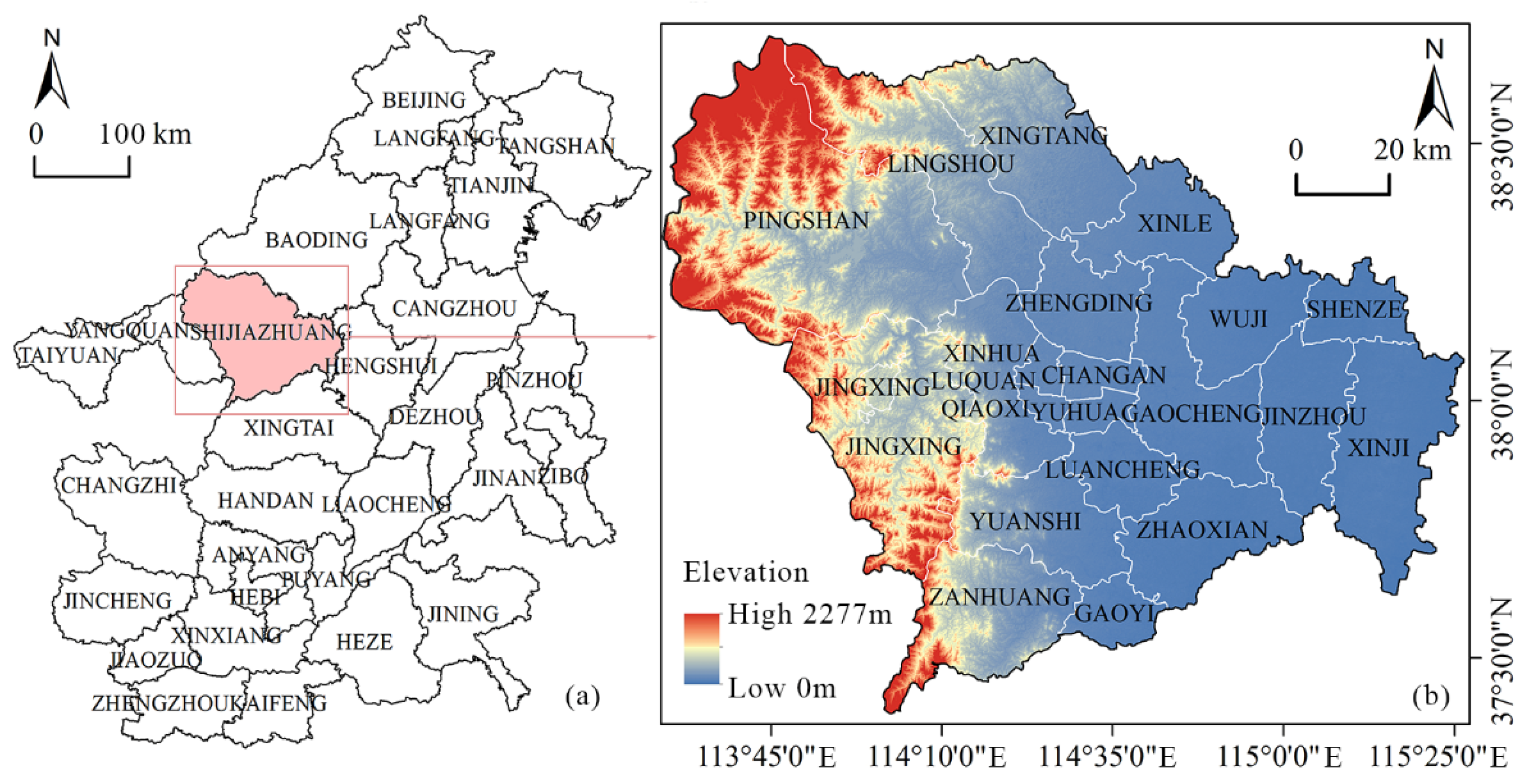

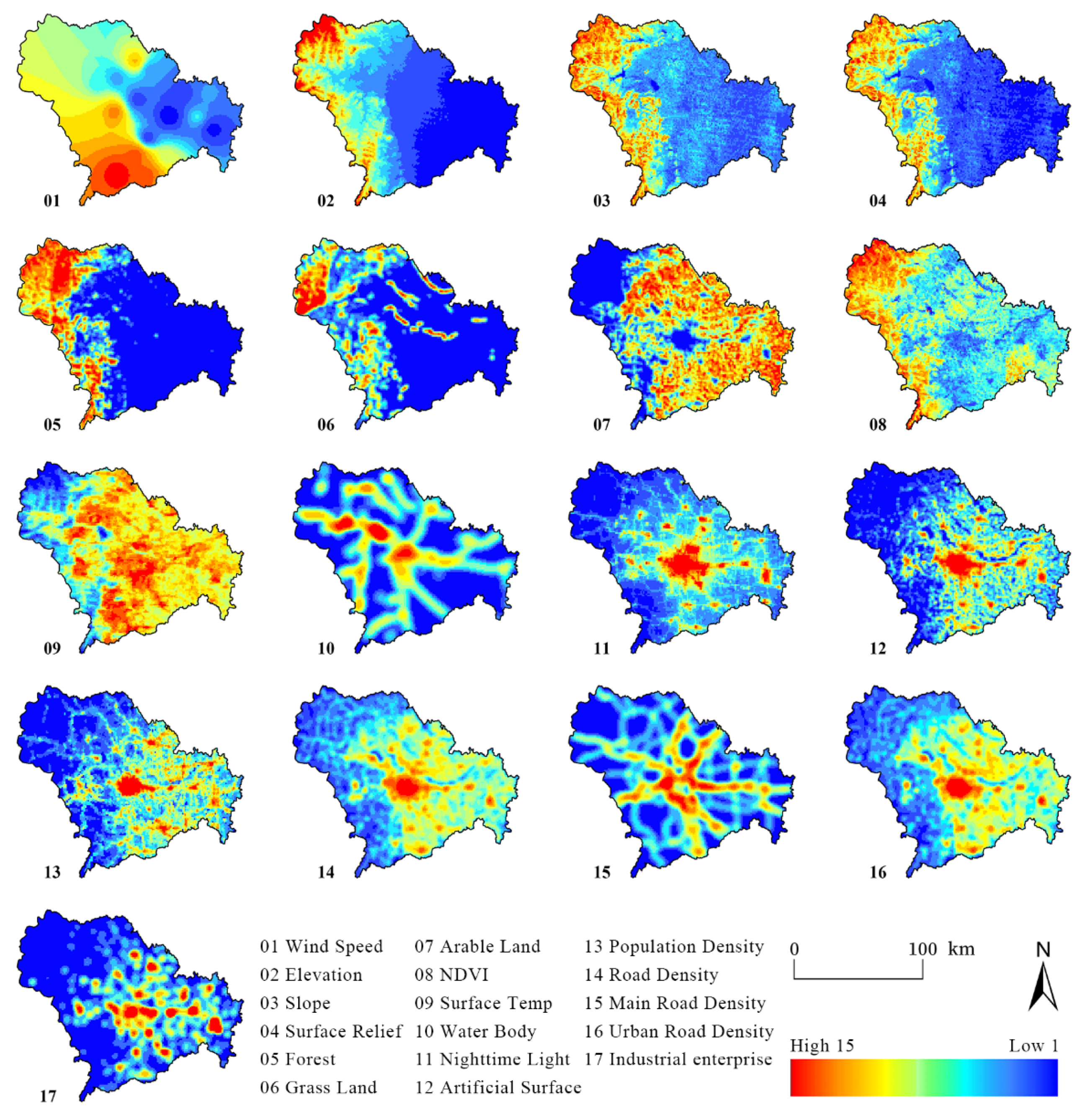
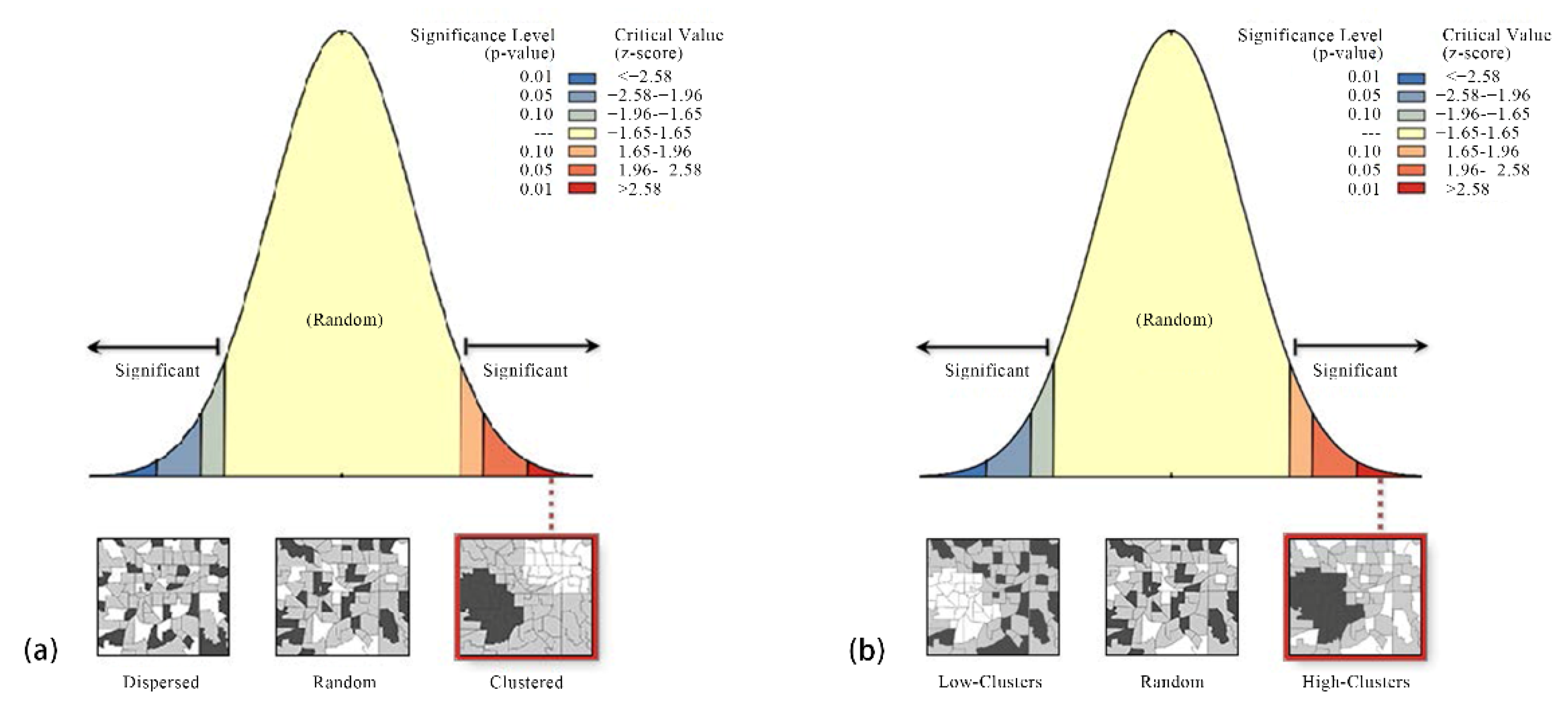

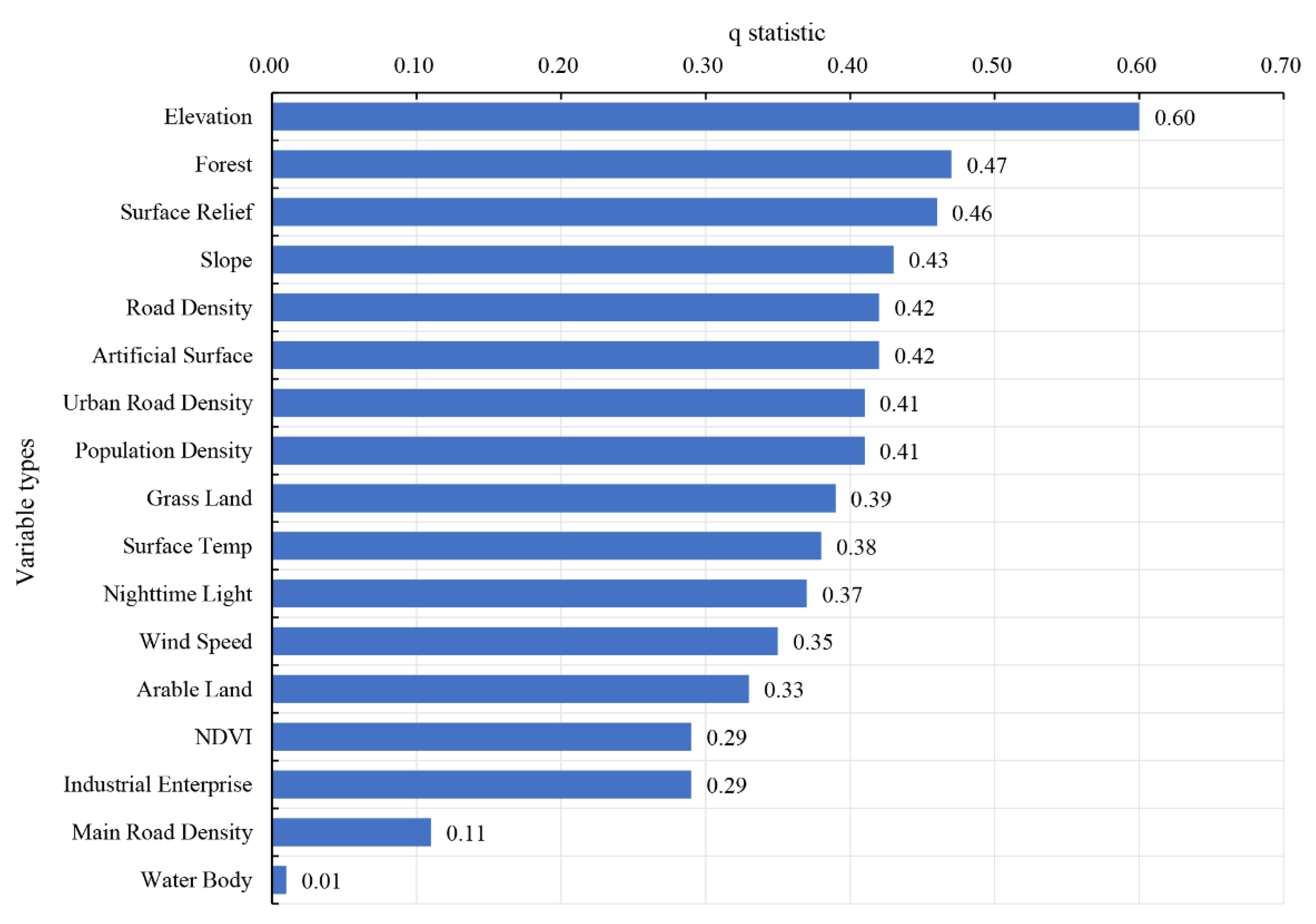


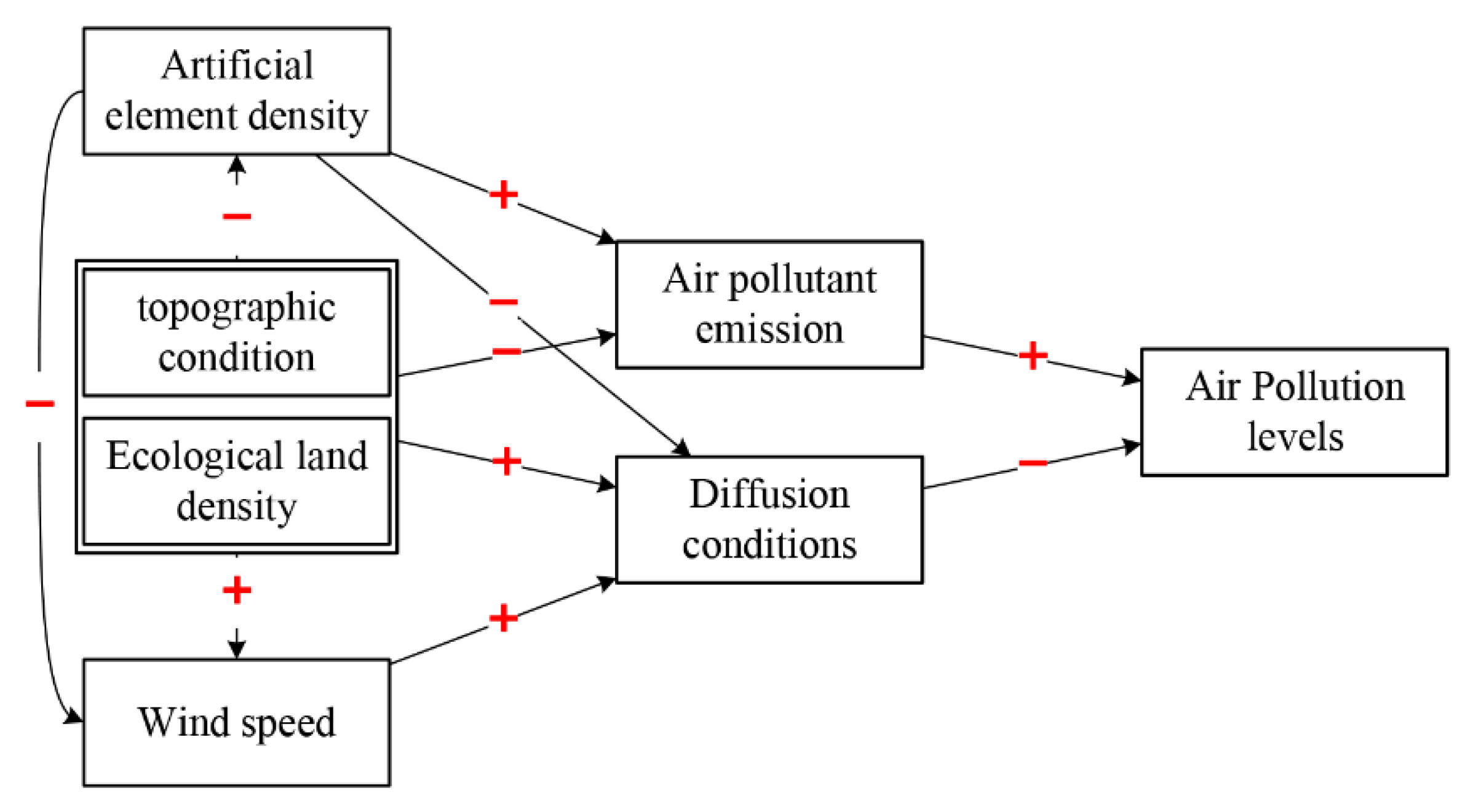
| Methods | Projects | Results |
|---|---|---|
| Moran’s I | Moran’s index | 0.977421 |
| Expected index | −0.000073 | |
| z score | 223.061996 | |
| p value | 0.000000 | |
| General G | Observed General G | 0.000001 |
| Expected General G | 0.000000 | |
| z score | 141.428016 | |
| p value | 0.000000 |
Publisher’s Note: MDPI stays neutral with regard to jurisdictional claims in published maps and institutional affiliations. |
© 2022 by the authors. Licensee MDPI, Basel, Switzerland. This article is an open access article distributed under the terms and conditions of the Creative Commons Attribution (CC BY) license (https://creativecommons.org/licenses/by/4.0/).
Share and Cite
Sun, Y.; Zeng, J.; Namaiti, A. Research on the Spatial Heterogeneity and Influencing Factors of Air Pollution: A Case Study in Shijiazhuang, China. Atmosphere 2022, 13, 670. https://doi.org/10.3390/atmos13050670
Sun Y, Zeng J, Namaiti A. Research on the Spatial Heterogeneity and Influencing Factors of Air Pollution: A Case Study in Shijiazhuang, China. Atmosphere. 2022; 13(5):670. https://doi.org/10.3390/atmos13050670
Chicago/Turabian StyleSun, Yuan, Jian Zeng, and Aihemaiti Namaiti. 2022. "Research on the Spatial Heterogeneity and Influencing Factors of Air Pollution: A Case Study in Shijiazhuang, China" Atmosphere 13, no. 5: 670. https://doi.org/10.3390/atmos13050670
APA StyleSun, Y., Zeng, J., & Namaiti, A. (2022). Research on the Spatial Heterogeneity and Influencing Factors of Air Pollution: A Case Study in Shijiazhuang, China. Atmosphere, 13(5), 670. https://doi.org/10.3390/atmos13050670







